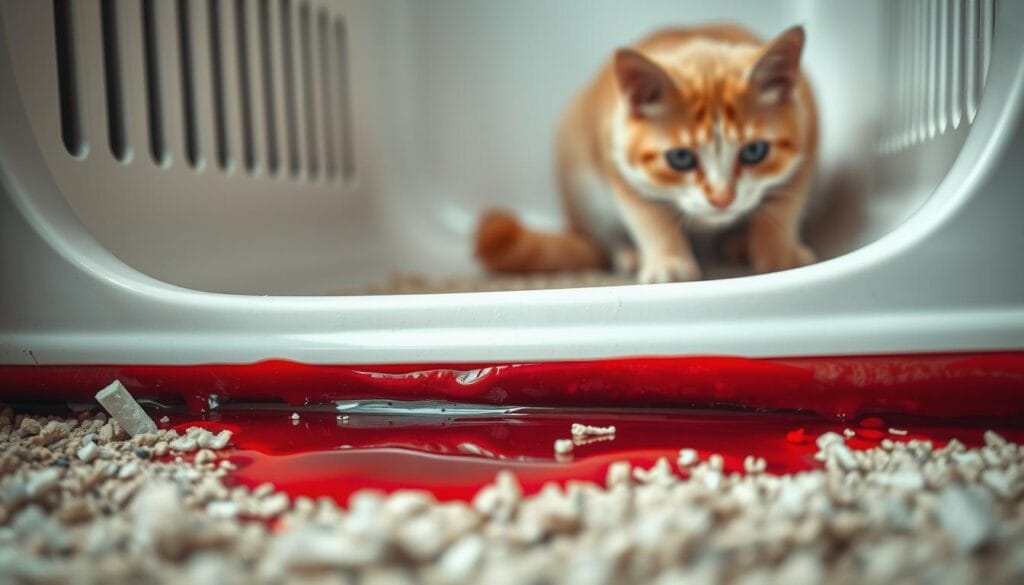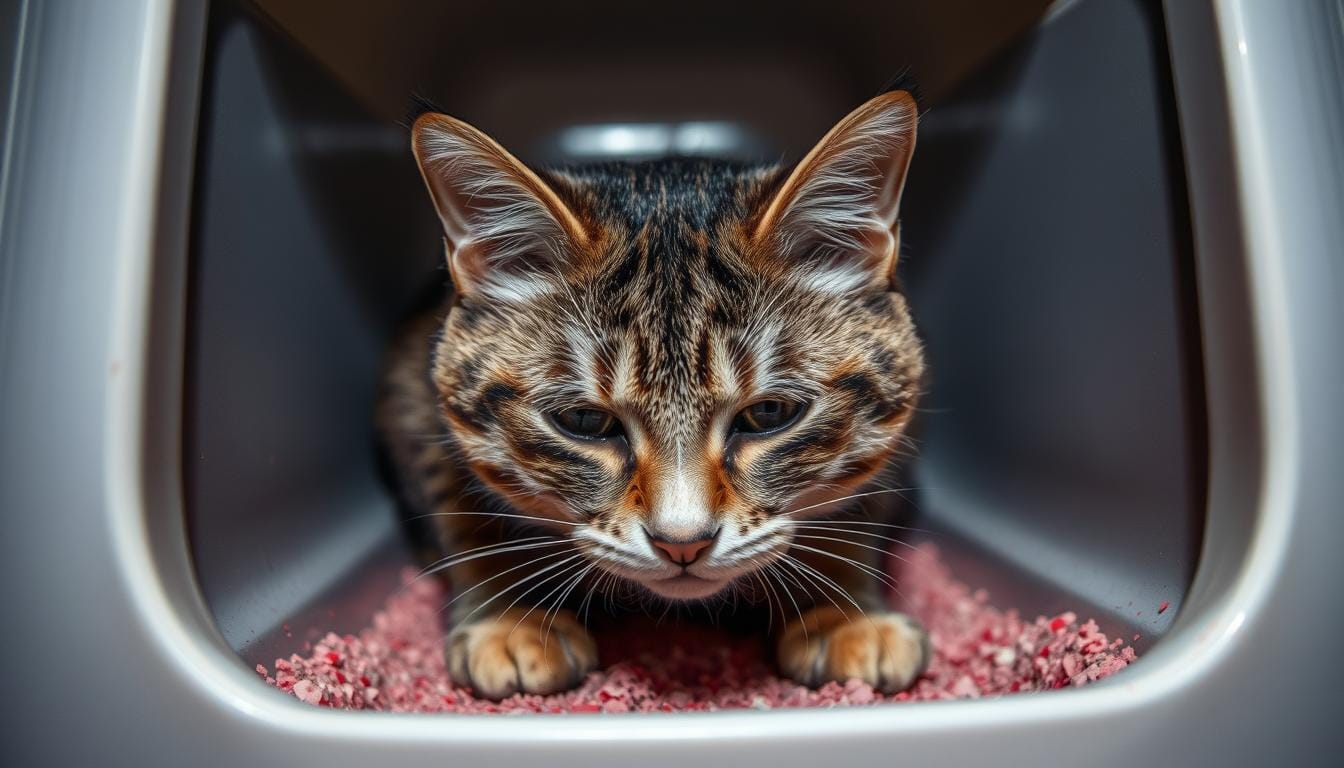Cat Peeing Blood: Causes, Treatment, and When to Seek Help
Seeing blood in your cat’s urine is scary. Feline idiopathic cystitis (FIC) is behind about 60% of cases of cat peeing blood . This means it’s a common reason for blood in their pee. Blood in cat urine can signal many health problems, from infections to stones in the bladder. If you see blood, it’s key to get your cat to the vet fast.
Table of Contents
It’s important to know why your cat might pee blood. This symptom can point to several health issues. Finding out what’s causing it is the first step to treating it. Blood in cat urine is a serious sign that needs quick vet care to avoid bigger problems.
Key Takeaways
- If you notice blood in your cat’s urine, seek veterinary help immediately to determine the underlying cause and provide proper treatment.
- Feline idiopathic cystitis (FIC) is a common cause of blood in cat urine, accounting for about 60% of cases.
- Urinary tract infections (UTIs) may account for approximately 20-25% of cases involving blood in cat urine.
- Cats that are hydrated and have regular access to fresh water show a 30% lower incidence of urinary-related health issues.
- Maintaining an enriched environment and regular access to clean litter boxes may help in preventing feline lower urinary tract disease (FLUTD) and cystitis.
- Therapeutic diets can assist in preventing the recurrence of bladder stones or crystals.
Understanding Blood in Cat Urine: An Overview
As a cat owner, watching your cat’s urine is key. Blood in cat urine, or hematuria, can signal a health issue. It might be due to infections, kidney stones, or cancer. If your cat’s pee looks different, get vet help fast.
Signs of blood in cat urine include bright red, pink, orange, and brown. These colors mean your cat might be sick. A vet will check your cat, ask about their health, and run tests to find out why.
What is Hematuria in Cats?
Hematuria means blood in the urine. It can come from infections, stones, or cancer. It’s split into microscopic and gross hematuria. Microscopic is only seen under a microscope, while gross is visible to the eye.
Common Signs of Blood in Cat Urine
The signs of blood in cat urine are:
- Bright red blood
- Pink tinge
- Orange discoloration
- Brown discoloration
Different Types of Urinary Discoloration
Urinary discoloration can happen for many reasons. It could be from diet, stress, or health issues. The types include:
- Yellow or amber-colored urine, which can mean concentrated urine
- Cloudy or murky urine, which might show a urinary tract infection
- Red or pink-colored urine, which could mean blood in the urine

Why is My Cat Peeing Blood? Common Causes
Seeing blood in cat urine can be scary for cat owners. There are many reasons why your cat might pee blood. These include problems with the urinary tract, injuries, or poisoning. Cat peeing blood often means there’s a health issue that needs a vet’s help.
Some common reasons for blood in cat urine are:
- Urinary tract infections (UTIs)
- Bladder stones
- Kidney stones
- Polycystic kidney disease
- Cancer
It’s important to talk to a vet to find out why your cat is peeing blood. They will check your cat, ask about their health, and might do tests like urinalysis or imaging. This helps figure out what’s wrong.

In some cases, blood in cat urine can mean a serious problem, like a blockage or kidney failure. If your cat drinks a lot of water, eats less, seems tired, or has trouble peeing, get them to the vet right away.
Urinary Tract Infections and Their Symptoms
As a cat owner, you might see your cat’s urine is cat brown urine or cat pink urine. This could mean they have a urinary tract infection (UTI). UTIs are not as common in cats as other urinary issues. But, they can make your pet very uncomfortable and affect their health.
Female cats are more likely to get UTIs than males. This is because of their body structure. Cats with diabetes, kidney disease, or hyperthyroidism are also at higher risk. Plus, cats with bladder stones often get UTIs again and again.
Bacterial Infections
Bacterial infections are a main reason for UTIs in cats. The most common bacteria causing UTIs is Escherichia coli, from feces. If not treated, a UTI can block the urethra. This can lead to kidney failure or even bladder rupture.
Risk Factors for UTIs
Several things can make a cat more likely to get a UTI, including:
- Age: Older female cats are more likely to get UTIs
- Sex: Female cats are more prone to UTIs than male cats
- Underlying medical conditions: Certain health issues, like diabetes and kidney disease, raise the risk
- Obesity: Overweight cats have a harder time grooming, which can increase UTI risk
Feline Lower Urinary Tract Disease (FLUTD)
As a cat owner, you might have seen your cat pee blood. This could mean they have Feline Lower Urinary Tract Disease (FLUTD). FLUTD is common in cats of all ages. It can make your cat strain to pee, go more often, and even pee outside the litter box.
Research shows FLUTD can happen in any cat, but it’s more common in young to middle-aged cats. The reasons for FLUTD vary, but urinary tract infections are a big cause. These infections happen in 5-15% of FLUTD cases. Bladder stones are another cause, and they can be very dangerous if they block the urethra.
Some important facts about FLUTD include:
- Male cats are more likely to have urethral obstruction from FLUTD.
- FLUTD symptoms can come back often, so managing it is a long-term job for owners.
- Improving FLUTD symptoms can take days, weeks, or even months.
To manage FLUTD well, you might need to change your cat’s environment and diet. Some special diets help increase water intake and lower the risk of bladder stones. If you think your cat is peeing blood, it’s important to see a vet to find the right treatment.
Kidney and Bladder Stones in Cats
As a cat owner, knowing why your cat’s pee might turn red is key. Cat pee color changes can signal health problems. Kidney and bladder stones are a common cause of blood in cat urine. These stones, made of minerals like struvite or calcium oxalate, can hurt your cat a lot.
Stones form when the urine’s mineral levels get too high. Cats who don’t drink enough water or pee often are more likely to get stones. If you see blood in cats wee, get vet help fast. It could mean a stone or another serious problem.
- Bladder stones can vary significantly in size, ranging from tiny and inconsequential to large and harmful.
- Kidney stones are always made of calcium oxalate and can be difficult to detect until they have grown very large.
- Treatment for bladder stones can include surgical intervention or laser therapy, but preventive measures, such as a diet rich in wet food, are essential to reduce the risk of stone formation.
Regular urine checks or ultrasound exams can spot bladder stone problems early. This lets you make diet changes to prevent more serious issues. Knowing about kidney and bladder stones helps you protect your cat’s health and avoid serious problems.
Emergency Signs When Your Cat is Peeing Blood
If your cat is peeing blood, it’s key to spot emergency signs fast. Difficulty urinating, straining, and vomiting are big warning signs. These can mean a serious health issue.
Blood in cat urine, or hematuria, can point to many problems. This includes urinary tract infections, kidney stones, or FLUTD.
Look out for these emergency signs:
- Increased frequency of urination
- Accidents outside the litter box
- Straining or crying while urinating
- Vomiting or lack of appetite
These signs might mean a serious issue like a urinary tract infection or kidney stones. They can cause blood in cat urine. If you see these signs, get vet help right away to avoid worse problems.
Remember, if your cat is peeing blood, it’s safer to get a vet’s advice quickly. Early treatment can greatly help your cat’s health and recovery.
Diagnostic Procedures and Tests
Seeing blood in cats wee means it’s time to see a vet. They will do a physical check-up. This includes looking at the kidneys, bladder, and genital area. It helps find any problems or sickness.
The vet might also suggest lab tests, like urinalysis. This checks for cat pee color changes, blood, or other urine issues. They might use X-rays or ultrasounds to find bladder stones or tumors.
These tests help figure out why there’s blood in cats wee. They guide the treatment plan. Working with a vet ensures your cat gets the right care and helps prevent future problems.
Some common tests include:
- Urinalysis
- Imaging studies (X-rays, ultrasounds)
- Bacterial culture
- Physical examination
These tests help find the cause of cat pee color changes. They help create a treatment plan to fix the issue.
Treatment Options and Recovery
If your cat is peeing blood, it’s key to see a vet. They will figure out the best treatment. This could be antibiotics or even surgery, depending on the cause.
For example, if your cat has a Urinary Tract Infection, they might need antibiotics. The vet will choose the right one based on tests.
Changing your cat’s diet might also be needed. This could mean switching to a special food to help with bladder stones. Surgical removal is often needed for certain types of stones.
It’s important to watch your cat closely during recovery. Males are at higher risk of urinary blockage, which can be serious.
Some common problems during recovery include:
- Loss of appetite
- Vomiting
- Diarrhea
These issues might need vet help. Regular check-ups are key to making sure your cat is okay. Keeping them hydrated is also important.
Changing your cat’s diet to wet or prescription food might be needed. Watch for signs of discomfort or changes in how they pee. These could mean they need more medical help.
By working with your vet, you can help your cat get better. This will also help prevent future problems.
Prevention and Lifestyle Changes
As a cat owner, you can take steps to lower the risk of blood in your cat’s urine. This includes cat brown urine or cat pink urine. Simple lifestyle changes can help prevent urinary tract issues and keep your cat healthy. Make sure your cat always has fresh water. This helps dilute toxins and lowers the risk of urinary problems.
A well-balanced diet is also key. Feed your cat a diet low in minerals like magnesium, phosphorus, and calcium. This can prevent urinary crystals and stones. Also, urinary diets can make urine slightly acidic. This helps prevent cat brown urine or cat pink urine.
Diet Modifications
- Feed a balanced diet that restricts mineral intake
- Choose a urinary diet that acidifies urine
- Avoid overfeeding, as obesity can increase the risk of urinary issues
Hydration Tips
Encourage your cat to drink more water. Place multiple water sources around the house. Make water more appealing with water fountains. This helps dilute your cat’s urine, reducing toxin and mineral concentration. This can prevent cat brown urine or cat pink urine.
When to Contact Your Veterinarian
If you see blood in cat urine, call your vet right away. This could mean your cat has a health problem like a urinary tract infection or kidney stones. Your vet will check your cat, ask about their health history, and might do tests like urinalysis or imaging.
It’s also important to keep up with vet visits to watch your cat’s health. This helps avoid serious problems and keeps your cat feeling their best. Some things that need vet help fast include:
- Urinary blockages in male cats
- Severe straining to urinate
- Frequent urination or vocalization during urination
By teaming up with your vet, you can help your cat get better from blood in cat urine or cat peeing blood. Early action and treatment are vital for keeping your cat’s urinary system healthy.
Long-term Management Strategies
Managing chronic conditions that cause blood in cats wee needs a long-term plan. This includes making lifestyle changes and keeping a close eye on the cat’s health. It’s also key to watch the cat pee color regularly, as changes can show underlying problems.
Some strategies for long-term management include:
- Providing a balanced diet that meets the cat’s nutritional needs
- Ensuring adequate hydration to help prevent urinary issues
- Creating a stress-free environment, which can help reduce the frequency of symptoms
It’s vital to work closely with a vet to create a personalized plan. This might include regular check-ups, medication, and changes to the cat’s diet and lifestyle. By being proactive, cat owners can manage their cat’s condition and improve their health and happiness.
Remember, every cat is unique, and what works for one might not work for another. By paying attention to changes in cat pee color and blood in cats wee, owners can act quickly to address any problems. This ensures their cat gets the best care possible.
Conclusion
If you’ve seen blood in your cat’s urine, get vet help right away. The reasons can be many, like infections or stones in the bladder. Early action is key to help your cat.
Working with your vet, you can find the cause and fix it. This will help your cat’s health and stop problems later.
Cats are strong, but they need us to look out for them. Be an active pet parent. Watch your cat’s pee closely and act fast if you see blood or other issues. Most blood in cat pee can be treated well. This lets your cat live a happy, healthy life again.
FAQ
What is hematuria in cats?
Hematuria is when blood is found in a cat’s urine. It often means there’s a health problem that needs a vet’s help.
What are the common signs of blood in a cat’s urine?
Signs include urine that’s pink, red, or brown. Cats may also pee more often or strain to do so.
What are the common causes of blood in a cat’s urine?
Blood in urine can be due to infections, FLUTD, stones, or sometimes cancer.
What are the symptoms of a urinary tract infection (UTI) in cats?
UTI symptoms are blood in urine, peeing more, straining, and pain while urinating. Both bacteria and viruses can cause UTIs.
What is feline lower urinary tract disease (FLUTD)?
FLUTD covers many issues like inflammation, infection, and stones in a cat’s lower urinary tract.
What types of urinary stones can cats develop?
Cats can get struvite, calcium oxalate, or urate stones. Treatment depends on the stone type.
What are the emergency signs that a cat is peeing blood?
Look out for frequent or painful peeing, blood clots, lethargy, loss of appetite, and vomiting. These are urgent signs.
What diagnostic tests might a vet perform to determine the cause of blood in a cat’s urine?
Vets might do a physical check, lab tests, and imaging like X-rays or ultrasound to find the cause.
What treatment options are available for cats with blood in their urine?
Treatment depends on the cause. It might include meds, diet changes, or surgery for stones or blockages.
How can I prevent my cat from peeing blood?
Keep your cat’s environment calm, ensure they drink enough, feed a balanced diet, and watch their litter box habits.
When should I contact my veterinarian about my cat peeing blood?
Call your vet right away if you see blood in your cat’s urine. It could be a serious issue.
How can I manage my cat’s condition if they have a chronic issue causing blood in their urine?
Managing chronic issues might involve meds, diet changes, enrichment, and regular vet visits to adjust treatment.
There are no reviews yet. Be the first one to write one.







